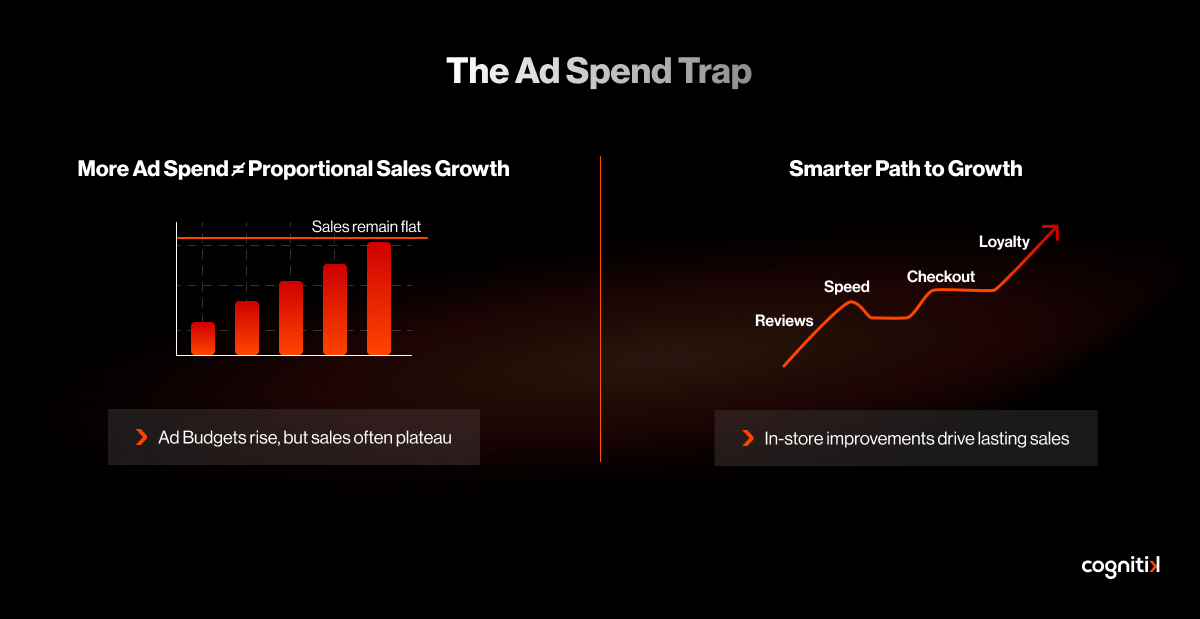
Shopify businesses often find themselves investing more in advertising without seeing a proportional rise in sales. This common challenge creates the impression that growth depends solely on expanding ad budgets. It is a challenge many businesses face, and it often creates the impression that the only way to grow is to keep increasing ad budgets.
The truth is that advertising is just one part of the equation. Real, sustainable growth comes from what happens after a visitor lands on your site, how seamless their experience is, how easily they can make a purchase, and how motivated they feel to return. These are the factors that turn casual browsers into loyal customers.
Our work with Shopify businesses across the United States has shown this pattern repeatedly. The encouraging part is that you do not need a bigger advertising budget to see better results. What you need are smarter, well-placed improvements inside your store that lift conversion rates and build long-term customer loyalty.
This guide brings together those proven strategies, designed to help you achieve growth that lasts. Let’s walk through them step by step.
1. Optimize Your Store for Conversions
Imagine walking into a store where the lights are dim, the shelves are disorganized, and the checkout takes forever. You would not stay long. Online shoppers feel the same frustration when a website is slow, clunky, or confusing. Research shows that even a one-second delay in loading time can reduce conversions by up to 7 percent.
Take Allbirds, the eco-friendly shoe brand that became hugely popular in the US. They did not grow purely on ads. Instead, they focused on site speed and simplicity, compressing images, removing unnecessary scripts, and streamlining navigation. The result was clear: people stayed longer on their site and completed more purchases.
You can apply the same approach to your Shopify store. Shopify provides built-in speed insights that show how quickly your pages load and what may be slowing them down. Use these reports to identify problem areas, remove apps that are too heavy, and test your store on mobile devices. Since most US shoppers browse on their phones, a slow or clunky mobile experience means lost sales.
At Cognitik, we have helped stores in the US optimize their product pages and mobile experience, which alone has driven noticeable sales lifts.
2. Leverage Email and SMS Marketing (Your Owned Channels)
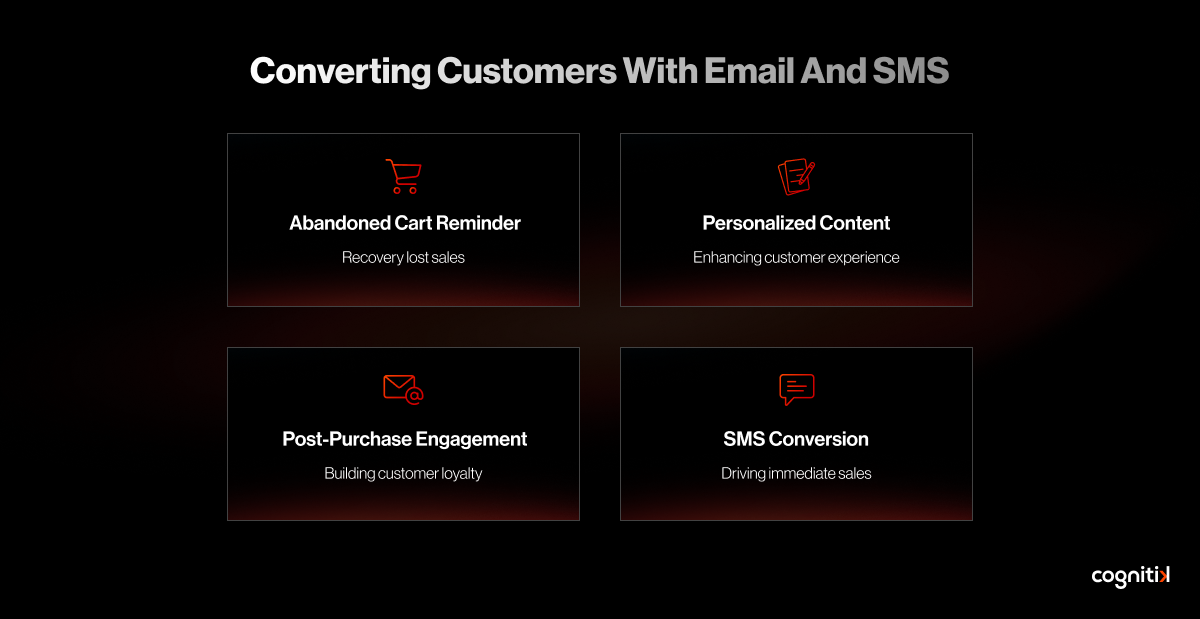
Paying Google or Meta for every click is like renting space you never own. Once you stop paying, the traffic disappears. Email and SMS marketing give you an audience you own, channels that can keep selling for you without ongoing ad spend.
Setting up simple flows, such as abandoned cart reminders, can recover up to 20 percent of lost sales. Post-purchase flows are equally powerful, letting you thank customers, share product tips, and recommend related items.
Beardbrand, an Austin-based grooming company, mastered this approach. They segmented their email list to send beard care tips to beard oil buyers and hair styling content to hair product buyers. The revenue per email grew significantly. SMS works just as well, often with open rates above 90 percent. A timely message like “Your cart is waiting, enjoy free shipping today” can quickly convert.
At Cognitik, we regularly set up automated flows for Shopify businesses in the US. Once created, these flows continue generating sales for months without additional ad costs.
3. Upselling and Cross-Selling
When a customer trusts you enough to buy one product, that is the best time to recommend another. Upselling and cross-selling are not pushy if done right; they are helpful. Think about a skincare brand in New York that sells cleanser, toner, and moisturizer individually, but also offers a discounted bundle. Customers feel like they are getting value, while the store raises its average order value.
Here’s a real-life example to better understand this concept.
Gymshark, which has a huge US customer base, often suggests matching sets right after checkout. For example, if a buyer adds leggings, they might see an offer for a matching sports bra at a lower price. This tactic significantly boosts order sizes and feels like a service, not a sales trick.
4. Build Customer Loyalty and Retention
Acquiring a new customer can cost up to seven times more than keeping an existing one. This is why customer loyalty should be a central focus for any US Shopify business.
Look at Sephora, a household name across the United States. Their Beauty Insider program gives shoppers points, exclusive perks, and access to new launches. It keeps customers coming back. Even smaller Shopify stores can create loyalty programs using apps that reward repeat purchases or reviews. Referrals are another winning tactic.
Dropbox, headquartered in San Francisco, grew rapidly by rewarding users who referred friends. On Shopify, you can easily replicate this by giving discounts to both the referrer and the new customer. Subscriptions are another proven retention model in the US. Products like coffee, vitamins, and pet food are perfect for this.
We saw this firsthand with a US pet supply brand that launched subscriptions. Within three months, they built a steady stream of recurring revenue that made their growth far more predictable.
5. Use Social Proof to Build Trust
American shoppers trust other customers more than brand advertising. Reviews, testimonials, and user-generated content are the online version of word of mouth, and they strongly influence purchase decisions. Research shows that 95 percent of US consumers read reviews before buying.
Glossier, a New York beauty company, built much of its success by showcasing real customer stories and selfies on social media. By reposting user-generated content on Instagram, they created a loyal community that kept growing.
Smaller US Shopify stores can do the same by displaying reviews prominently on product pages, embedding Instagram feeds on their site, and using apps like Judge.me to make reviews easy to collect.
Adding trust badges, payment security logos, or mentions in US press outlets further reassures American shoppers that your brand is safe to buy from.
6. Enhance Your Checkout Experience
The checkout page is where many sales vanish. In the US, cart abandonment rates are as high as 70 percent, but the right tweaks can reverse this. Simplifying the process into a single-page checkout reduces friction. Offering multiple payment methods such as Shop Pay, PayPal, and Buy Now Pay Later options like Klarna or Afterpay caters to American shoppers’ preferences.
One US-based fashion brand saw sales jump by 25 percent after adding Klarna. Exit intent offers also work well. For example, if a customer is about to leave, you can trigger a pop-up offering free shipping if they complete the purchase immediately.
7. Content and SEO to Drive Free Traffic
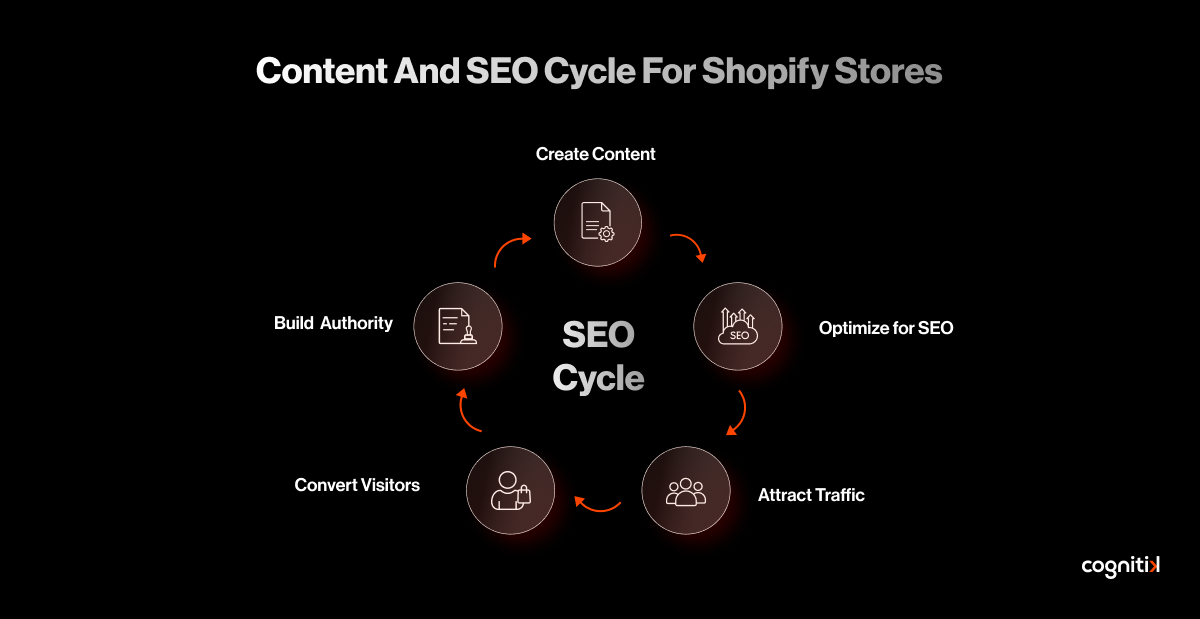
Paid ads stop working when the budget runs out. Content and SEO continue attracting shoppers for free. A Shopify blog lets you target what US buyers are searching for every day. For example, a California fitness gear store can publish “Best Home Workouts for Beginners” to draw organic traffic from search engines month after month.
REI, based in Washington, is a perfect example. Their detailed gear guides rank on Google and bring millions of organic visitors who are ready to buy. Even small US stores can benefit by optimizing product titles, descriptions, and images with the right keywords.
One simple fix we often recommend to US Shopify clients is renaming products to match the exact phrases customers are typing into Google. Small SEO tweaks like these can open up steady streams of organic traffic.
If you are not already creating content, start now. A steady flow of blogs, guides, and how-to articles gives your Shopify store long-term visibility and authority. Even a few well-written posts can drive consistent traffic, and with time, that content becomes one of your most valuable sales assets. And if you need guidance on building the right content strategy for your Shopify store, Cognitik can help you turn organic reach into steady revenue.
8. Leverage Organic Social Media and Communities
Not every sale needs to begin with ads. Many US Shopify stores are growing quickly with organic social media. TikTok, Instagram Reels, and Pinterest have all produced viral moments for small businesses. A simple behind-the-scenes video, a creative product demo, or even a customer unboxing can capture attention at scale.
Micro influencers in the US are another cost-effective option. They often charge less than big influencers but deliver higher engagement because their audiences trust them more. Beyond influencers, US communities on Reddit, Facebook groups, and even Discord channels are great places to build genuine relationships with potential buyers.
9. Improve Customer Support Experience
Customer support is not just about solving problems; it is also a way to increase sales. US shoppers expect quick answers, whether it is about product availability, sizing, or shipping times. Adding live chat or AI chatbots helps you catch those opportunities instantly.
Zappos, headquartered in Las Vegas, built its billion-dollar reputation on exceptional support. Their team went above and beyond, and the payoff was customer loyalty. Even smaller US Shopify stores can adopt this mindset by being proactive. Sending an update about a delayed shipment or including a thank-you note in a package creates trust. These small efforts turn buyers into repeat customers who spread the word for free.
10. Tap Into Analytics and A/B Testing
Guessing rarely works in e-commerce. Data is the key. Shopify Analytics shows you which products convert best and where customers drop off. Tools like Hotjar provide heatmaps and session recordings, helping you see how shoppers interact with your site.
A/B testing is where the biggest breakthroughs often come. By testing two variations of a headline, button color, or checkout flow, you can find what truly works for your audience.
One US fashion brand we worked with tested a small change, switching the color of their checkout button. The store already had plenty of visitors adding items to their cart, but too many were dropping off before completing the purchase. Through a simple A/B test, they tried a brighter, more visible button against the original design.
In just a few weeks, the new version lifted conversions by 14 percent. The lesson was clear: small design tweaks, when tested with data, can unlock meaningful gains without a full redesign.
11. Use the Right Shopify Apps (But Keep It Lean)
The Shopify App Store is full of tools that can make your life easier. From upsell apps like Bold Upsell to loyalty programs such as Smile.io and review apps like Loox, there are plenty of powerful options for US merchants.
The risk is overloading your store with too many apps, which can slow down speed and frustrate customers. The smarter approach is to pick only the apps that directly support your sales goals. Keep your setup lean, and your store will stay fast, functional, and customer-friendly.
How Do You Compare? Shopify Benchmarks to Watch
When you work hard on your store but do not see results, it helps to know what is normal. The average Shopify conversion rate is between 1.4 and 2.5 percent. Cart abandonment is even higher, with about 70 percent of shoppers adding products but never checking out.
Knowing these numbers changes how you look at your own performance. If you are converting below 1 percent, it means there are critical problems to fix. If you are closer to 2 percent, the focus should be on small improvements that create steady growth. Benchmarks give you a reality check so you can set goals that make sense.
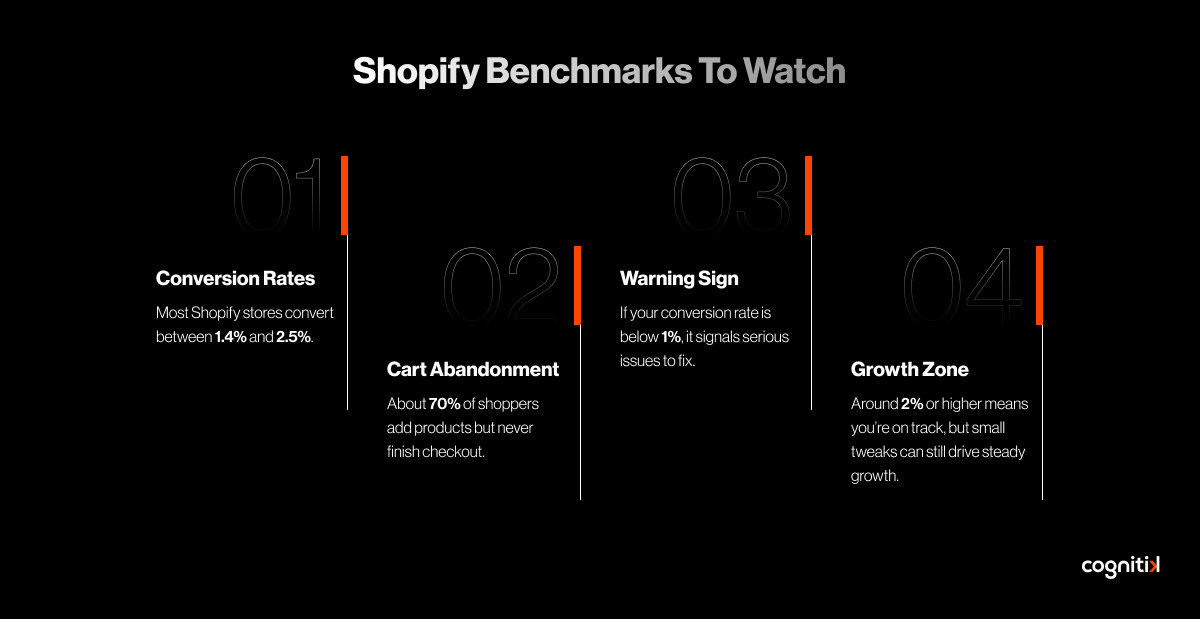
- Conversion rates: Most Shopify stores convert between 1.4% and 2.5%.
- Cart abandonment: About 70% of shoppers add products but never finish checkout.
- Warning sign: If your conversion rate is below 1%, it signals serious issues to fix.
- Growth zone: Around 2% or higher means you’re on track, but small tweaks can still drive steady growth.
Mistakes That Quietly Kill Sales
Many stores lose sales because of issues they do not even notice. One example is loading too many apps. Every Shopify app adds weight, and just like an overloaded bag slows you down, heavy apps slow your site. Customers leave before pages finish loading.
Another silent killer is poor mobile design. Most shoppers in the US browse on their phones. If your product pages are hard to scroll or buttons are too small to tap, people will exit quickly.
Finally, copying competitors without defining your own edge is risky. What works for one store may not suit yours. Instead of duplicating, focus on what makes your brand different and communicate that clearly. These small mistakes might not scream for attention, but together they quietly hold back growth.
Avoid these mistakes and boost your Shopify experience organically.
- Too many apps: Every Shopify app adds weight, slowing down your store. A slow site frustrates customers and increases abandonment.
- Poor mobile experience: With most shoppers browsing on phones, clunky navigation, hard-to-read text, or tiny buttons drive people away instantly.
- Copying competitors blindly: Replicating another store’s design or pricing without focusing on your unique edge makes you forgettable.
- Weak product descriptions: Generic or unclear descriptions leave customers confused. Without benefits explained, even great products fail to sell.
- Low-quality images: Blurry or inconsistent visuals hurt trust. Shoppers want to “see” quality before they buy.
- Complicated checkout: Extra steps, forced account creation, or missing payment options are all reasons shoppers abandon their cart.
- Ignoring site speed: Even a one-second delay can reduce conversions by 7 percent. Speed is not just technical; it is part of customer experience.
- Lack of trust signals: Missing reviews, testimonials, or security badges makes buyers hesitate, especially first-time visitors.
- No clear value proposition: If your homepage does not quickly answer “why buy from you,” visitors leave without exploring further.
- Over-reliance on ads: Depending only on paid ads for traffic without building retention or organic channels leads to unsustainable growth.
Quick Wins and Long-Term Wins
Think of your improvements in two parts. Quick wins are small changes that show results quickly. Adding reviews to product pages or setting up abandoned cart emails are good examples. They can recover lost sales within days.
Long-term wins require patience but bring steady results. SEO is one such lever. Blogs and optimized product descriptions may take months to build momentum, but once they do, they bring consistent traffic without extra costs. Loyalty programs or subscriptions also belong here. They take effort to set up, but once active, they bring predictable revenue.
When you separate improvements this way, it becomes easier to decide what to work on now and what to invest in for the future.
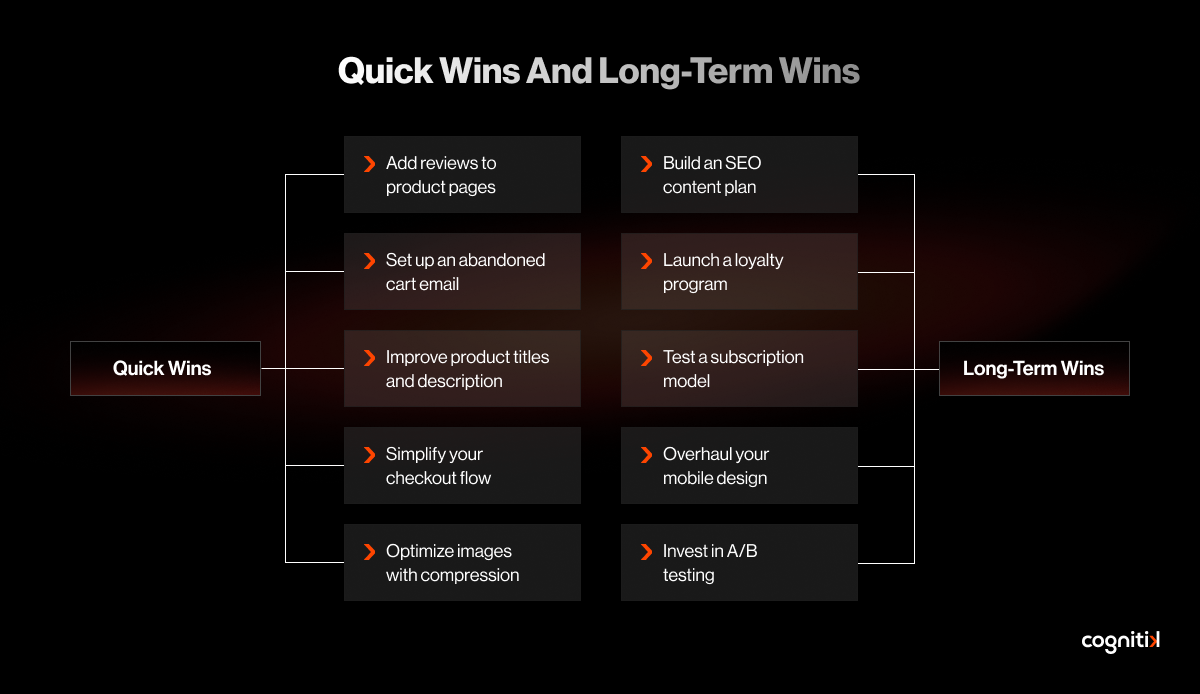
Quick Wins (fast results you can implement right away):
- Add customer reviews or testimonials to your top product pages to build instant trust.
- Set up an abandoned cart email or SMS reminder to recover lost sales.
- Improve product titles and descriptions with clear, benefit-driven language.
- Simplify your checkout flow by removing one unnecessary step or enabling guest checkout.
- Optimize images with compression tools so pages load faster.
Long-Term Wins (strategies that take time but pay off steadily):
- Build an SEO content plan with product-focused blogs and how-to guides.
- Launch a loyalty program to reward repeat purchases and referrals.
- Test a subscription model for consumable products like food, beauty, or pet supplies.
- Create a mobile-first design overhaul to improve the experience across devices.
- Invest in A/B testing to refine buttons, layouts, and headlines based on data.
Takeaway: Work on at least one quick win this week to create visible impact, and commit to one long-term win that strengthens your store for the future. When both play together, you see steady growth instead of short bursts.
Conclusion: Growth Without Bigger Ad Spend
Boosting Shopify sales is not about spending more on ads. It is about making your store smarter, smoother, and more enjoyable for customers. From speeding up your site to building loyalty programs, every strategy we discussed can work on its own. But when combined, they create a compounding effect that drives sustainable growth.
At Cognitik, we have partnered with Shopify businesses across the United States and have seen these strategies transform sales. The takeaway is simple: focus on customer experience, and the revenue will follow.
So here is your next step: pick just one of these strategies today. Whether it is setting up an abandoned cart email, adding more reviews, or optimizing your product pages, you will quickly see how small changes can lead to big results.